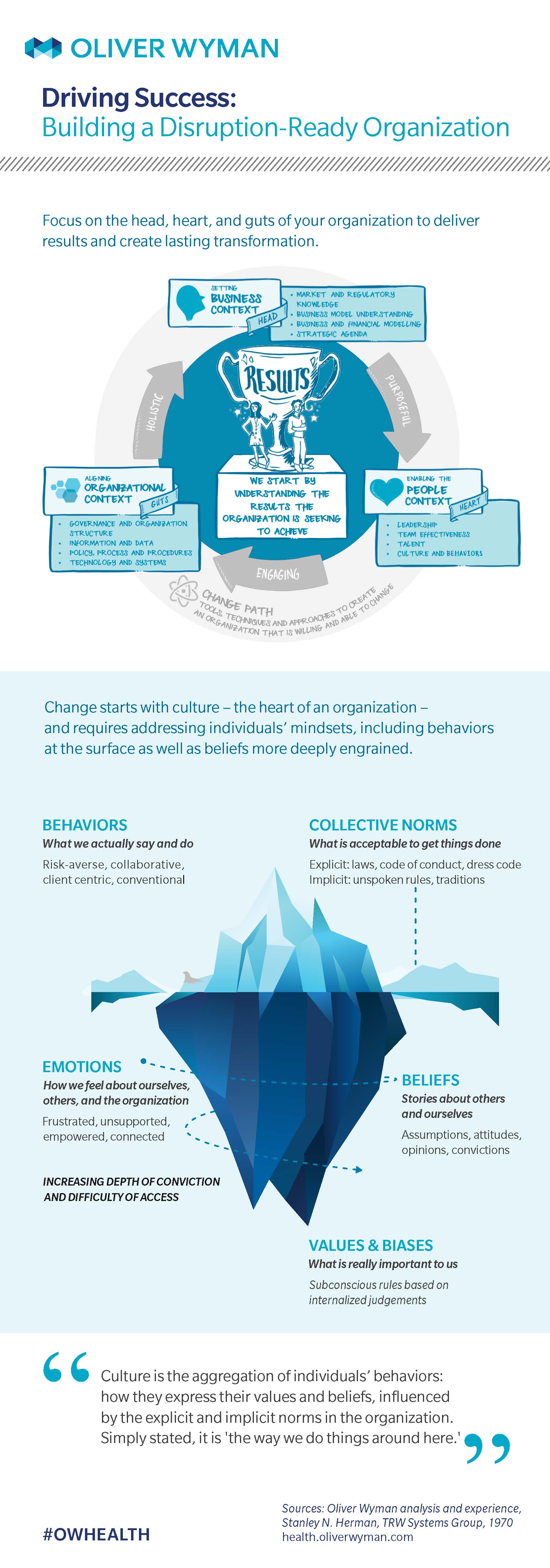While some industries have been deeply disrupted by technology already, disruption in healthcare is just starting. Advanced technology and outside-in innovation have disrupted many industries, creating completely new business models, enhanced customer offerings, and transformed consumer experiences. Healthcare, however, is only at the very beginning of realizing the disruptive power of technology and innovation.
Healthcare organizations must evolve to be ready to survive disruption and benefit and thrive from innovation. But how can incumbents reinvent themselves to be "disruption-ready"? What are the characteristics of those well-prepared organizations that effortlessly embrace innovations and have the agility and flexibility to react quickly to change? How can healthcare executives, leaders, and influencers modernize and rejuvenate their mindset?
These questions were discussed at the 2017 Oliver Wyman Health Innovation Summit, where nearly 300 healthcare influencers convened over three days last November in Dallas for an in-depth exploration of forces disrupting the healthcare industry.
One particular executive session our team led – Driving Success: Building a Disruption-Ready Organization – including panelists Marco Annunziata, former Chief Economist and Executive Director at Global Market Insights of General Electric, Rich Roth, Chief Strategic Innovation Officer at Dignity Health, and facilitated by Simon Holland, Oliver Wyman Partner and Head of Oliver Wyman’s North American Organizational Effectiveness practice, highlighted how one out-of-industry enterprise reinvented itself amidst rapid, transformative innovation.
Here is the panelists’ advice for how healthcare businesses can become disruption-ready:
Develop a People-Focused Culture
Healthcare organizations can prepare for future disruptions early on by experimenting with projects that focus on areas where next big waves of noteworthy changes are expected to disrupt the industry. Healthcare businesses must recognize risk as crucial for success and become more tolerant of experiments and failure.
A nimble and agile organization focuses not only on its operational business model and processes, but also on identifying its greater cultural impact. Consider how organizations’ values and culture impact long-term organizational goals.
Organizations that prepare for disruption-readiness are generally focused on enabling advancement by removing or streamlining excessive checks and balances, such as a traditional staged implementation approach. But it is equally important that employees consider disruption as something they have power and control over. Most talks of nimble and agile organizations tend to focus on the general business model’s organizational structure and the utilization of specific processes, as opposed to discussions of transforming the people – such as the culture, mindset, and behaviors – behind these processes.
For example, the latter focus on people (not processes) helped increase General Electric’s disruption-readiness when former General Electric Vice Chair, Beth Comstock, transformed the company’s greater culture from being tied to consistency and quality to that of cultural agility and flexibility. The result? Launch of the Fast Works initiative, an innovative framework for entrepreneurs that ultimately launched transformative products, like a refrigerator with French doors. Here, General Electric incorporated ongoing customer feedback into its product development and manufacturing processes, thus aligning evolving organizational ideas with live consumer feedback. This non-traditional business model changed General Electric’s mindset by making speed a top priority, thereby conditioning employees that it is indeed acceptable to experiment, fail, and return to the drawing board.
Reinvent the Talent Model
Considering General Electric’s example, evaluate where your current talent pool is strongest and weakest. Then, formulate strategies to fill in gaps whenever necessary, considering how partnerships can address your most immediate needs. Therefore, augmentation and supplementation with outside talent will ensure your talent pool is designed to thrive amidst uncertainty.
An organization can reinvent itself when individuals take on more leadership roles that highlight their greatest professional strengths. For example, consider how better integration of clinical stations can solve your most pressing daily challenges, or how adapting a digital tool may increase organizational agility.
General Electric, for instance, changed its recruiting process to ensure the company remained agile. The company’s hiring model was originally built on the expansion of entry level positions. When the company began hiring more individuals with outside experience, the average company seniority declined. But hiring people with a variety of seniority levels and a wider range of backgrounds widened the company’s greater perspective and increased expertise across the board.
At another organization, Dignity Health, employees once lacked diversity regarding the breadth of their professional backgrounds. Since then, the company’s hiring practices have evolved. Bringing in the best talent means considering that someone with an administrative background may also be superb at leading a clinic, or a physician can find tremendous fulfillment leading operations. Embrace a culture where people can supplement their skills and are not merely put into a category they can never escape from.
Embrace Risk and Experimentation
Offering direct recognition to those colleagues with innovative, accretive ideas that drive an organization forward is very important. Develop strategies that ensure senior executives and leaders do not cling to the status quo by default, but rather are open-minded to transforming organizational culture from the inside out. A successful company embraces holistic experimentation, and openly acknowledges that when ideas and experiments fail, you may actually be one step closer to industry-wide progression and advancement.
That is, breaking traditional mindsets means relying less on strong internal processes but more on balancing organizational risk with those processes.
If an employee skips an approval process because she deems this step irrelevant and expects it will just delay a deadline, consider the reasoning behind her choice to embrace more risk while increasing performance speed. It is ineffective to merely penalize her by default for failing to work according to pre-established guidelines.
Promote Transparent, Productive Meetings and Decision-Making
Panelists accomplished this by showing employees concrete examples of how embracing risk accelerates organizational effectiveness. For example, as part of General Electric’s Fast Works initiative, informal sessions were held with employees across all business units and departments. During these meetings, employees were shown tangible examples of what exactly slowed down a particular project’s deadline. Employers were often unaware how their undesirable practices impacted the organization, said panelists.
Leaders must lead by example – starting with themselves. For instance, they should focus on increasing a team’s speed by eliminating unnecessary meetings. Whereas more mundane, time-consuming tasks, like conference calls and ongoing committee responsibilities, reduce organizational competency, leading more critical-thought-heavy discussions drives ongoing transformation. Remove roadblocks by eliminating meetings not tied to results whenever possible, and ensure discussions are useful and productive.
Continuous rejection of innovative ideas or a pervasive feeling that nothing will ever change within a company discourages employees. But shattering this mentality will ensure the industry can conquer future disruptions and thrive. Create the right culture, adjust the talent model, be open to risk, and foster a high efficiency/high productivity environment.
Click here to watch healthcare influencers, including the CEOs of AARP, Skymind, Sutter Health, and Thomas Jefferson University and Jefferson Health, talk healthcare’s disruption at the 2017 Oliver Wyman Health Innovation Summit.


